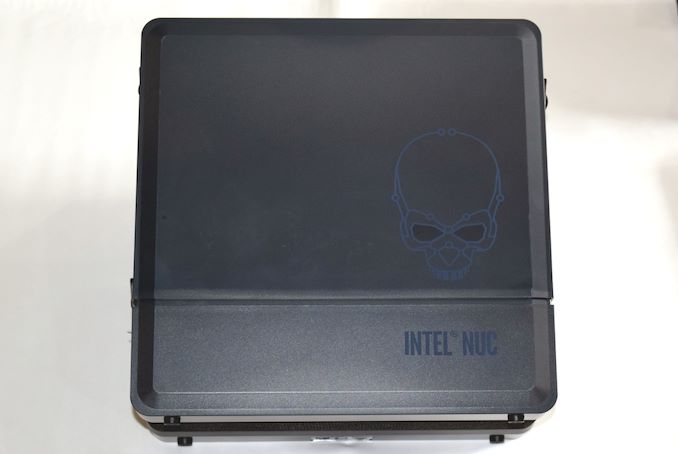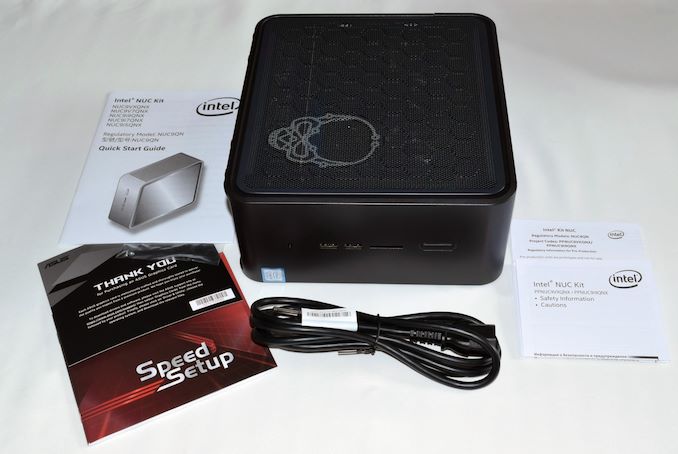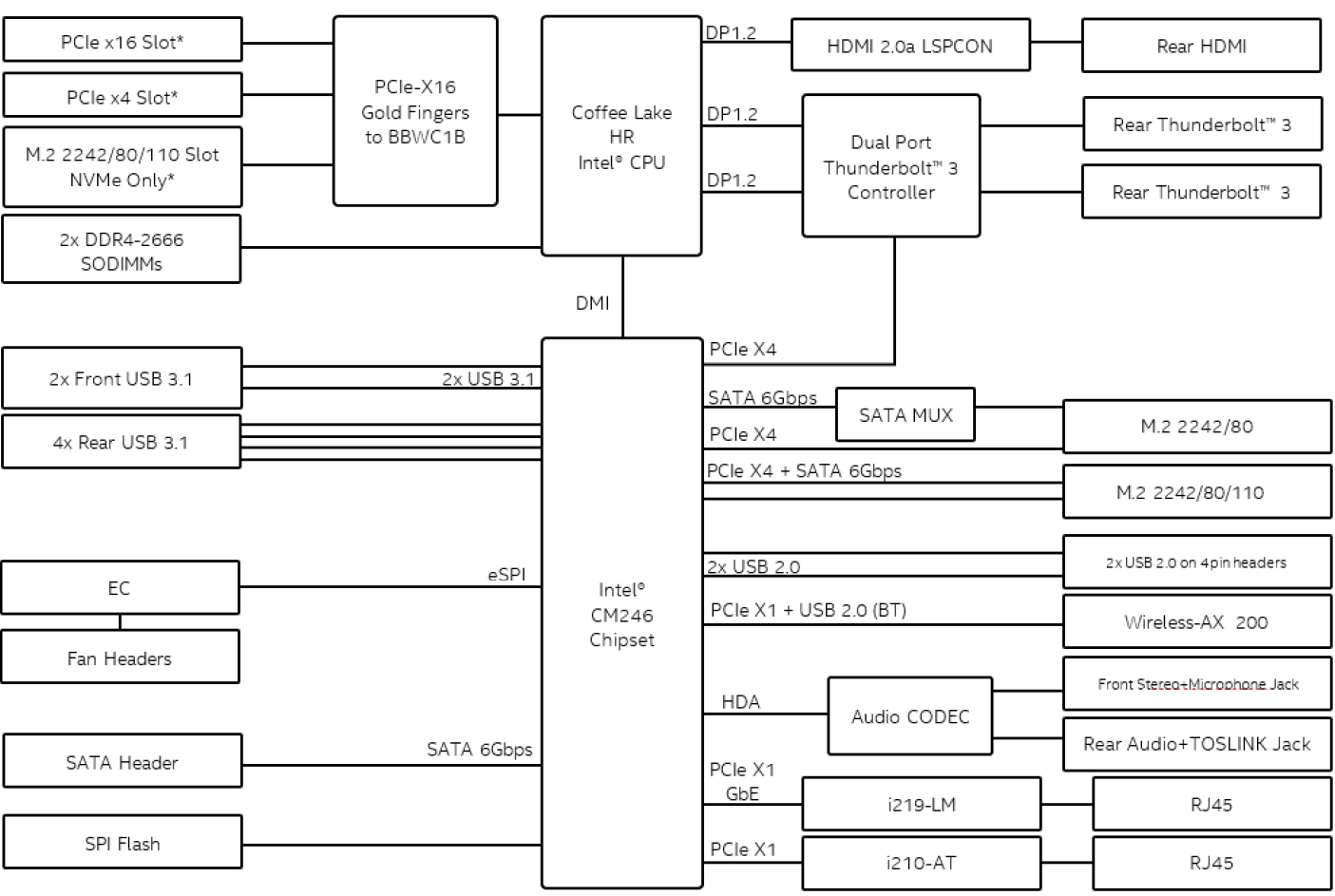Intel Ghost Canyon NUC9i9QNX Review: NUC 9 Extreme Realizes the SFF Dream
by Ganesh T S on April 16, 2020 8:05 AM ESTSetup Notes and Platform Analysis
The NUC 9 Extreme Kit is packaged in a fancy hard casing, signifying its premium nature. Since we had a system configuration essentially ready to benchmark, the package contents only included a few manuals and regulatory information notes along with a US power cord.
We noted the re-design of the Visual BIOS in our Frost Canyon NUC review. The NUC9i9QNX also uses the same re-designed interface. Unlike the mainstream NUC10i7FNH, the NUC9i9QNX has a few enthusiast options including the ability to fine-tune the DRAM timing parameters from a performance perspective. The entire gamut of options available in the latest BIOS (v0034) of the NUC9i9QNX is brought out in the gallery below.
The specifications of our Intel NUC9i9QNX review configuration are summarized in the table below.
| Intel NUC9i9QNX (Ghost Canyon) Specifications | |
| Processor | Intel Core i9-9980HK Coffee Lake-H, 8C/16T, 2.4 (5.0) GHz 16MB L2+L3, 14nm (optimized), 45W TDP |
| Memory | Kingston HyperX KHX3200C20S4/8G DDR4 SODIMM 17-19-19-35 @ 2666 MHz 2x8 GB |
| Graphics | ASUS Dual GeForce RTX 2070 MINI 8GB GDDR6 Intel UHD Graphics 630 |
| Disk Drive(s) | Intel SSD 905p Optane SSDPEL1D380GA (380 GB; M.2 Type 22110 PCIe 3.0 x4 NVMe; Optane / 3D XPoint) Kingston KC2000 SKC2000M81000G (1TB; M.2 Type 2280 PCIe 3.0 x4 NVMe; Toshiba 96L 3D TLC; Silicon Motion SM2262EN Controller) |
| Networking | Intel Wi-Fi 6 AX200 (2x2 802.11ax - 2400 Mbps) 1x Intel I219-LM Gigabit Ethernet Adapter 1x Intel I210 Gigabit Ethernet Adapter |
| Audio | 3.5mm Audio Jack (Front) Optical TOSLINK output (Rear) Capable of 5.1/7.1 digital output with HD audio bitstreaming (HDMI) |
| Miscellaneous I/O Ports | 1x UHS-II SDXC Slot (Front) 2x USB 3.2 Gen 2 (10 Gbps) Type-A (Front) 4x USB 3.2 Gen 2 (10 Gbps) Type-A (Rear) 2x Thunderbolt 3 (40 Gbps) Type-C (Rear) |
| Operating System | Retail unit is barebones, but we installed Windows 10 Enterprise x64 |
| Pricing (As configured) | $2810 |
| Full Specifications | Intel NUC9i9QNX Specifications |
The block diagram of the components of the NUC9i9QNX are presented in the diagram below.
One of the aspects that needs to be pointed out here is that the 2x Front USB 3.1 ports specified in the diagram above are physically the ones on the Compute Element, and not on the front panel of the chassis. The diagram does bring out the PCIe lanes bifurcation in the baseboard, though.
Our review sample came with Windows 10 Home x64 pre-installed, but, we wiped the drive and installed Windows 10 Enterprise x64 1909 along with the March 2020 cumulative updates prior to benchmarking. Our initial benchmarking and reports collection was done without opening up the system. The AIDA64 system report for the hardware configuration supplied by Intel provided the following information:
- [ North Bridge: Intel Comet Lake-H IMC ]:
- PCIe 3.0 x8 port #2 In Use @ x8 (nVIDIA GeForce RTX 2070 Video Adapter, nVIDIA TU106 - High Definition Audio Controller)
- PCIe 3.0 x4 port #4 In Use @ x4 (Intel Optane SSD 900p NVMe Controller)
- [ South Bridge: Intel Cannon Point CM246 ]:
- PCIe 3.0 x1 port #1 In Use @ x1 (Intel Wi-Fi 6 AX200 160MHz Wireless Network Adapter)
- PCIe 3.0 x4 port #5 In Use @ x4 (Intel Titan Ridge Thunderbolt 3 Controller)
- PCIe 3.0 x4 port #9 In Use @ x4 (Silicon Motion SM2262 PCIe 3.0 x4 NVMe 1.3 SSD Controller - Kingston KC2000)
- PCIe 3.0 x1 port #14 In Use @ x1 (Intel I210 Gigabit Network Connection)
We were puzzled by the discrete GPU operating in x8 mode instead of x16 (as it could affect gaming performance). After reaching out to Intel, we got additional context for the review configuration. As noted briefly a bit earlier, the M.2 slot on the baseboard is directly attached to the CPU, using PCIe lanes from it rather than off of the chipset. So the power-hungry, but high-performance 905p Optane drive in the baseboard slot makes sense in that context, as Intel is giving it the best possible (and least contested) connection to the CPU in order to highlight the capabilities of CPU-attached storage.
As evident from the block diagram, the Thunderbolt ports, USB ports, and the M.2 slots on the Compute Element are attached to the chipset, which means sharing the DMI link and its maximum bandwidth of PCIe 3.0 x4 (4GB/s). Which compared to typical systems, is actually a lighter load than usual; by hanging the Optane drive off of the CPU, there's less contention for the rest of the DMI link's resources, enabling additional testing areas such as elimination of noise from Thunderbolt 3 testing and allowing for RAID-0/1 on the Compute Element. Overall this opens up a few different configuration options, so in order to highlight the pros and cons of splitting the x16 slot with a SSD, we also tested the NUC with the Optane drive hanging off of the PCH, giving the video card a full x16 slot's worth of bandwidth. This is noted as x16 in the rest of the review to signify the operation of the RTX 2070 in x16 mode.
The AIDA64 system report for the x16 configuration has a slightly tweaked version of the PCIe lane usage specified earlier:
- [ North Bridge: Intel Comet Lake-H IMC ]:
- PCIe 3.0 x16 port #2 In Use @ x8 (nVIDIA GeForce RTX 2070 Video Adapter, nVIDIA TU106 - High Definition Audio Controller)
- [ South Bridge: Intel Cannon Point CM246 ]:
- PCIe 3.0 x1 port #1 In Use @ x1 (Intel Wi-Fi 6 AX200 160MHz Wireless Network Adapter)
- PCIe 3.0 x4 port #5 In Use @ x4 (Intel Titan Ridge Thunderbolt 3 Controller)
- PCIe 3.0 x4 port #9 In Use @ x4 (Intel Optane SSD 900p NVMe Controller)
- PCIe 3.0 x1 port #14 In Use @ x1 (Intel I210 Gigabit Network Connection)
- PCIe 3.0 x4 port #21 In Use @ x4 (Silicon Motion SM2262 PCIe 3.0 x4 NVMe 1.3 SSD Controller - Kingston KC2000)
The NUC9i9QNX is a relatively unique system. We have evaluated SFF systems with discrete GPUs in the last few years. Systems such as the Hades Canyon NUC came with a co-packaged discrete GPU leaving no scope for the end-user to upgrade the graphics performance without buying an entirely new computer. We've also had systems with a real discrete GPU such as the ASRock DeskMini Z370 GTX1060 and the Zotac ZBOX MAGNUS EN1080K. Theoretically, users could upgrade the installed MXM card to get better graphics performance, but practically speaking, MXM card upgrades are incredibly rare and almost never officially supported by system manufacturers.
This leaves us with one true precursor to the Ghost Canyon NUC - the Zotac ZBOX MAGNUS EK71080. This 5.7L compact gaming powerhouse internally sports a single-fan version of the Zotac GTX 1080 Mini complete with the external PCIe power connector, and nothing preventing the end-user from replacing it with a similar-sized GPU. Obviously, Zotac would not officially support this, but it only serves to show that accommodation of user-replaceable discrete GPUs in compact SFF systems has been possible before. The Compute Element initiative from Intel has been accompanied by the creation of an ecosystem where add-in card vendors now have an incentive to create discrete GPU cards within the 202mm x 131mm form-factor. Along with chassis designs like the one in the NUC9i9QNX, this has now enabled sub-5L systems capable of sporting powerful user-replaceable discrete GPUs.
In the table below, we have an overview of the various systems that we are comparing the Intel NUC9i9QNX against. Note that they may not belong to the same market segment. The relevant configuration details of the machines are provided so that readers have an understanding of why some benchmark numbers are skewed for or against the Intel NUC9i9QNX when we come to those sections.
| Comparative PC Configurations | ||
| Aspect | Intel NUC9i9QNX (Ghost Canyon) | |
| CPU | Intel Core i9-9980HK | Intel Core i9-9980HK |
| GPU | ASUS Dual GeForce RTX 2070 MINI 8GB GDDR6 Intel UHD Graphics 630 |
ASUS Dual GeForce RTX 2070 MINI 8GB GDDR6 Intel UHD Graphics 630 |
| RAM | Kingston HyperX KHX3200C20S4/8G DDR4 SODIMM 17-19-19-35 @ 2666 MHz 2x8 GB |
Kingston HyperX KHX3200C20S4/8G DDR4 SODIMM 17-19-19-35 @ 2666 MHz 2x8 GB |
| Storage | Intel SSD 905p Optane SSDPEL1D380GA (380 GB; M.2 Type 22110 PCIe 3.0 x4 NVMe; Optane / 3D XPoint) Kingston KC2000 SKC2000M81000G (1TB; M.2 Type 2280 PCIe 3.0 x4 NVMe; Toshiba 96L 3D TLC; Silicon Motion SM2262EN Controller) |
Intel SSD 905p Optane SSDPEL1D380GA (380 GB; M.2 Type 22110 PCIe 3.0 x4 NVMe; Optane / 3D XPoint) Kingston KC2000 SKC2000M81000G (1TB; M.2 Type 2280 PCIe 3.0 x4 NVMe; Toshiba 96L 3D TLC; Silicon Motion SM2262EN Controller) |
| Wi-Fi | Intel Wi-Fi 6 AX200 (2x2 802.11ax - 2400 Mbps) |
Intel Wi-Fi 6 AX200 (2x2 802.11ax - 2400 Mbps) |
| Price (in USD, when built) | $1553 (barebones) $2810 (as configured) |
$1553 (barebones) $2810 (as configured) |



















109 Comments
View All Comments
Namisecond - Friday, April 17, 2020 - link
Thirded, the sandwich design the Dancase A4 popularized really revolutionized the DIY SFF world. We are living in the golden age of DIY SFF. :)Namisecond - Friday, April 17, 2020 - link
In this case, what is Intel offering for their for their roughly $500-$600 plastic chassis and proprietary unbranded PSU? Superior Intel marketing? I feel your Dan A4 analogy sarcasm is spot on, but I think the reasons it's spot on does not extend to the NUC 9.imaheadcase - Thursday, April 16, 2020 - link
Unless you got some very specific need for this, not worth getting. Lots of these are used for home media streaming setups, so needing something this powerful is overkill. You can get 4k streaming/movies or whatever on the price of a low end 5 year old NUC or more.BlazingDragon - Thursday, April 16, 2020 - link
Agreed.The seems like the result of a "hey, we could do this" thought process, rather than "we should do this"...
Massively overpriced for home use.... Enthusiasts will build their own, much cheaper and more capable system, and normal buyers will never pay this much... they could just buy a much cheaper standard PC [for GPU], or a much cheaper Intel NUC8 or NUC10 [or Zotac, etc., equivalent] if gfx performance is not important.
GamersNexus has a detailed review on Youtube which aligns with the above.
Maybe the Xeon based Quartz Canyon will find business customers who need/value the small size, but I'm not convinced...
For anyone interested, prices for all NUC9 models are available [and for pre-order] here: shopblt.com
Deicidium369 - Friday, April 17, 2020 - link
Agreed - like I said I have no clue what the use case for this is. Even the Xeon unit...erinadreno - Thursday, April 16, 2020 - link
There are plenty of sff itx case, I mean really sff case(4~6L), out there. They cost from $30 to $200, plus a $120 Enhanced 7660b, which is a 600w PSU instead of 500. Standard high end itx boards costs $300 at best. If you spend the same $1500 on those stuff, you'd left south of 1000 bucks. Heck, you can even get a Xeon 8136 28c CPU at this point (although your only option for motherboard is that ONE ASRock server board and some janky coolers).I just don't see the value of this okay-sized box in 2020. As in the past couple years the itx market just expand that much. Just give up on graphics and buy a regular nuc or build your own stuff.
pixelstuff - Thursday, April 16, 2020 - link
That seems really large for a "Next Unit of Computing" classification.Deicidium369 - Friday, April 17, 2020 - link
Agreed - for me the NUC is the 4.5"x4.5" units - even the Hades Canyon to me doesn't meet the classification.Oxford Guy - Friday, April 17, 2020 - link
My dream is for people to mature enough to demand that Intel not be idiotic enough to put skulls on things.Cullinaire - Friday, April 17, 2020 - link
How about a pelvis instead?